Month 8 running a Peugeot 308 GTI: time for the first service
The 308 needs servicing every 12,500 miles (some rivals go 50% further between scheduled stops), and the first was due when I visited family in Cumbria. A quick search revealed Kendal dealership David Hayton undercut those near CAR by about £30.
I booked online, and unchecked ‘also change spark plugs’. The dealership was no-frills and friendly.
In three hours it was serviced and washed (though the kid-muddied interior was ignored) and I was £146.71 poorer.
By Ben Barry
Month 7 running a Peugeot 308 GTI: track day!
The last time I drove the Silverstone GP circuit, I was strapped in a Bentley GT3 racecar, so some recalibration was required for the 308 GTI. But after enjoying the Peugeot so much on the road, I was keen to see how it performed on track.
Gold Track (goldtrack.co.uk) run a number of events on UK and European circuits, so I booked onto one of their excellent open pitlane days. It cost £399 for a Monday session, and is super-flexible and relaxed: turn up when you want, go on track when you want.
It’s safe to say the Peugeot looked a little out of its depth in the paddock, with Caterhams, 911 GT3 RSs, Ferraris, Radicals and even an LMP car in the mix. I could only exceed expectations, which wasn’t a bad place to be as I headed out for my first laps.
Peugeot makes no excuses that the 308 is a less focussed machine than its 208 GTI; it has to be, because people like me actually use those rear doors for carrying kids. But it’s a great introduction to a demanding track like Silverstone: quick and entertaining enough to be fun, but still safe, slow and confidence-inspiring enough when you’re not quite sure what you’re up to.

Compared with the couple of other trackdays I’ve done, there was less traffic at Silverstone, meaning less time spent being frustrated and held up. It took a few minutes to adjust to the Peugeot’s body roll and front-end scrabble that isn’t so noticeable on the road, but is massively amplified by the space and speed of a racetrack. But the eager power, excellent Alcon brakes, clawing limited-slip diff and beautifully weighted steering all impressed, and after some initial laps with the stability control left on while I found a rhythm, I turned it all off. That’s when you can really start bringing the GTI’s playful rear end into play… and get yourself into trouble at a place this fast. A flurry of fourth-gear wheel twirling at Abbey proved that.
The most exciting section of Silverstone is the flicks through Maggotts and Becketts. You carry all the speed you can into the first left, and straight-line it right to the apex of the following right-hander that lies in a little compression. From there you hug the kerb over the crest into the next left, and dip again into a right. The Peugeot’s four-piston brakes gave me the confidence and control to leave the braking as late as possible, and the mobile rear end helped position the car, but it’s a really challenging section: one mistake ruins the whole sequence, and massively hits your speed on the long run down Hangar Straight.
Eventually it all clicked, and a couple of things really seemed to help my fluidity. Firstly, rolling a little more speed into some of the slower corners, rather than braking harder and accelerating earlier, which caused understeer. Secondly, feathering the throttle on and off to adjust the car’s balance through the fast right at Stowe, rather than just sticking with a constant throttle.
I was out on track for a maximum of two hours. While the brakes fared well, Silverstone is fast, and I remember looking down and seeing 120mph just before braking into Brooklands. Since then, the brakes still work, but there’s a pronounced grumble every time I step on the middle pedal.
The Michelin Super Sports, surprisingly, did a little better. Perhaps the generally fast layout helped – rather than lots of tyre-frying second-gear stuff – and I limited my hot laps to four at a time. The result is plenty of meat left after 10,000 miles and a blitz around Silverstone.
By Ben Barry
Logbook Peugeot 308 GTI 270
Engine 1598cc 16v turbocharged 4-cylinder, 268bhp @ 6000rpm, 243lb ft @ 1900rpm
Gearbox Six-speed manual, limited-slip differential, front-wheel drive
Stats 6.0sec 0-62mph, 155mph (limited), 139g/km CO2
Price £28,455
As tested £29,870
Miles this month 1158
Total miles 10734
Our mpg 34.9
Official mpg 47.1
Fuel cost this month £178.47
Extra costs £0
Month 6 running a Peugeot 308 GTi 270: what’s the point of a Sport button that makes the car less enjoyable to drive?
Briefly experimented with the Sport button this month. It doesn’t firm up the dampers as some do, but does bring more fizz to the throttle.
The thing is, the throttle is more controllable and less hyperactive in its default setting. It also switches the speedo and rev counter from white to red. The rev counter’s already confusing, because the needle sweeps backwards. Illuminating everything in red compounds this by removing the redline markings. In Sport mode, aren’t drivers more likely to need them?
By Ben Barry
Logbook: Peugeot 308 GTi 270
Engine: 1598cc 16v turbo 4-cyl, 268bhp @ 6000rpm, 243lb ft @ 1900rpm
Gearbox: 6-spd manual, fwd
Stats: 6.0sec 0-62mph, 155mph, 139g/km CO2
Price: £29,870
As tested: £28,455
Miles this month: 1567 Total: 9576
Our mpg: 28.3 Official mpg: 47.1
Fuel: £287.27
Extra costs: £0
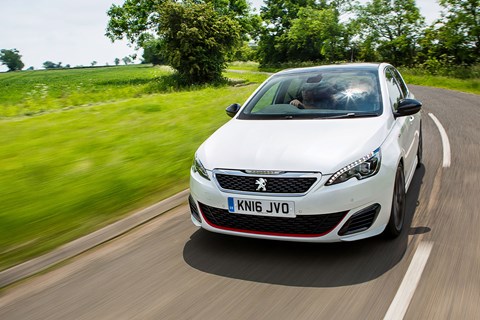
Month 5 running a Peugeot 308 GTi 270: a tasting menu
Those left without any appetite by recent soggy warmed-over Peugeots, listen up. We believe we’re onto something…
Brilliant brakes, definitive diff
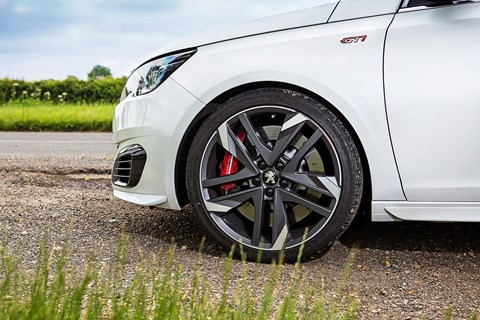
Stepping from 250 to 270 spec carries a £1600 premium, but it’s worth it. Highlights are an extra 20bhp, but also the super-strong Alcon brakes and a proper mechanical slip diff. The latter claws big traction through corners, though can tug the car about when you overtake on a cambered road.
Seriously sensuous seats

Superb seats are unique to 270. The leather bits are fake, you perch too high, but they look great and offer daily driver comfort with good lateral support. Peugeot underplays the standard massage function. Press a button and the lumbar support gently rolls over your lower back. I never forget to switch it on.
Ebulliently energetic engine
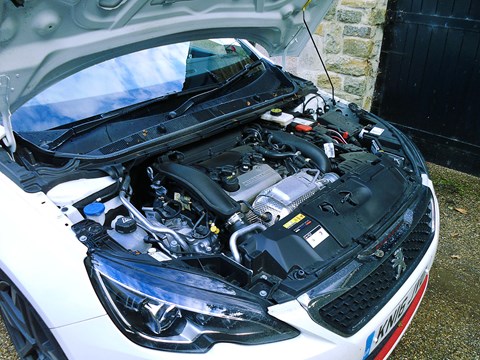
The 270’s 1.6-litre turbo four isn’t the world’s most powerful production engine. It feels flat until 2800rpm if you leave a junction in second, but you rarely notice, instead focusing on the serious turn of speed. We’re typically averaging 31mpg – this month’s 36mpg is a high.
Revelatory, recalcitrant roof
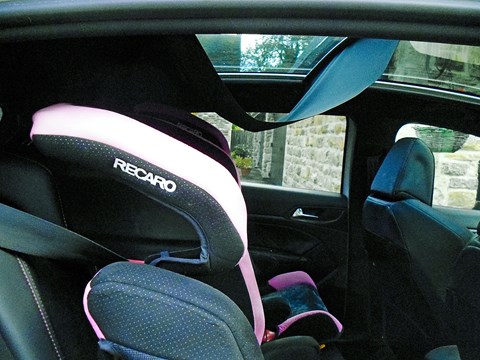
Fixed panoramic roof is a £500 option. Makes the cabin feel airier, but also adds weight up high for a worse centre of gravity. We have a problem with the blind: when you wind it right back, it falls down and completely veils my children. Actually, is that a problem?
By Ben Barry
Logbook: Peugeot 308 GTi 270
Engine: 1598cc turbo 4-cyl, 268bhp @ 6000rpm, 243lb ft @ 1900rpm
Transmission: Six-speed manual, fwd
Stats: 6.0sec 0-62mph, 155mph (limited), 47.1mpg, 139g/km CO2
Price: £28,455
As tested: £29,870
Miles this month: 2418
Total: 8009
Our mpg: 36.1
Official mpg: 47.1
Fuel: £348.32
Extra costs: £0
Month 4 running a Peugeot 308 hot hatch: fuel economy
After 5591 miles we’ve got some representative mpg from the GTi and its punchy 268bhp 1.6 turbo. This month’s 28.4mpg is a low, the average so far is 31.3mpg.
To put that in context, our 308 is city-averse, mostly roaming freely on A- and B-roads, or flowing with motorway traffic on long runs.
More context: my previous Golf R – 30bhp more from a larger 2.0-litre engine – averaged 29mpg over similar mileage.
The smaller Peugeot engine feels stronger – the GTi is 200kg or so lighter than the awd Golf – so it’s a win-win.
By Ben Barry
Logbook: Peugeot 308 GTi 270
Engine: 1598cc turbo 4-cyl, 268bhp @ 6000rpm, 243lb ft @ 1900rpm
Transmission: Six-speed manual, fwd
Stats: 6.0sec 0-62mph, 155mph (limited), 47.1mpg, 139g/km CO2
Price: £28,455
As tested: £29,870
Miles this month: 1860
Total: 5591
Our mpg: 28.4
Official mpg: 47.1
Fuel: £361.88
Extra costs: £0

Month 3 running a Peugeot 308 GTi 270: gained in translation
‘First impressions are good, but we’ll have to wait until we drive it in the UK to be sure,’ concludes many a first drive. Well, almost four thousand miles in, and the GTi feels as good as when I first drove one in France. Those wait-and-see verdicts often reference how well suspension tackles British roads, and while the 308’s springs and passive dampers are reasonably stiff, it’s still got enough compliance to work as both a family tool and B-road hacker.
You get some serious kit when you upgrade to the 270 version, including a limited-slip differential and Alcon four-piston brakes. Feeling the diff pull you round a corner on-power when you might expect understeer really adds to the involvement. It isn’t totally vice-free, tugging a bit on more heavily cambered roads, but I think it’s a worthwhile trade.
The brakes are a key plus versus some rivals. They quietly do their bit during daily driving, then stand the Pug on its nose with a lovely firm, clean pedal feel as you stamp it into the carpet. There’s a bit of lag low down from the turbo 1.6, but it’s a firecracker of an engine, and I find the handling balance really sweet: massive front-end grip with an adjustable rear that the stability control lets move around a little, though you can disable everything.
In other news, last month I was proved both correct and incorrect. Correct because I said Peugeot’s prediction that the 308 GTi sales split would be 80/20 in favour of the 250 model would be wrong, and it is actually 75-80% in favour of the 270. Incorrect because I misread the email from Peugeot. They called it right.
At the same time, I also discovered the spring-rate specs that Peugeot gave us during the GTi prototype drive were off. The springs are actually 56% stiffer at the front, 64% at the rear compared with the 308 GT, not 60% front/100% rear.
By Ben Barry
Logbook: Peugeot 308 GTi 270
Engine 1598cc 16v turbo 4-cyl, 268bhp @ 6000rpm, 243lb ft @ 1900rpm
Transmission 6-speed manual, front-wheel drive
Stats 6.0sec 0-62mph, 155mph (limited), 139g/km
Price £28,455
As tested £29,870
Miles this month 1213
Total miles 3731
Our mpg 31.6
Official mpg 47.1
Fuel cost this month £194.10
Extra costs (this month) £0
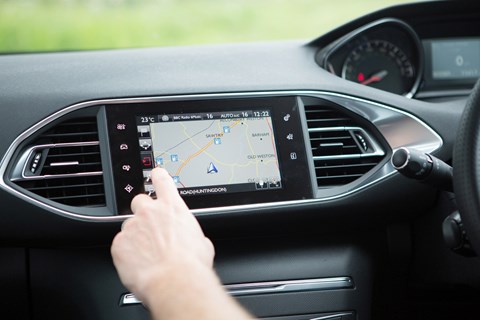
Month 2 running a Peugeot 308 GTi 270: touchscreen tribulations
Much enjoyment being had in the 308 GTi so far, but I’ll save that for a longer update. First, a quick moan: the Peugeot migrates many functions to a touchscreen, including climate controls.
Compared with traditional rotary dials, you spend more time with eyes off the road, and the GTi’s firmish suspension exacerbates things because it’s harder to be accurate with your prods. I end up leaning forward, grabbing the dash to steady myself, then pressing the buttons with my thumb. This isn’t progress.
Logbook: Peugeot 308 GTi 270
Engine 1598cc 16v turbo 4-cyl, 268bhp @ 6000rpm, 243lb ft @ 1900rpm
Gearbox 6-spd man, fwd
Stats 6.0sec 0-62mph, 155mph (ltd), 139g/km
Price £28,445
As tested £29,870
Miles this month 1128
Total 2518
Our mpg 31.3
Official mpg 47.1
Fuel £180.98
Extra costs £0
By Ben Barry

Month 1 running a Peugeot 308 GTi 270: the introduction
The Volkswagen Golf R has gone, a Peugeot 308 GTi has taken its place, and the consensus among friends and family is that I’ve surely upset the editor. Instead of the nods of appreciation that greeted news of the Golf’s arrival, I now see sideways glances and open mouths pausing to find polite words. But I lobbied to run this car after following a Peugeot test driver down twisting Tour de France and World Rally test routes for hours in a pre-production model last year. The adjustable chassis, the feelsome steering and wieldy wheel, the clawing diff, punchy power and serious brakes… I loved it all.
If first impressions held up to examination, I thought, the 308 could carry the torch on from the old 205 GTi and 306 GTi-6, two of the finest hot hatches ever made. After years of Peugeot getting something of a kicking, I imagined CAR readers – many of you growing up during those cars’ glory days – would be interested to read about a return to form, but might think twice about parting with your own hard-earned cash.
So that’s what this long-term test is really about; can a great-driving French car keep its nose clean during our tenure so that I’m as much an advocate for it when it goes back as I am now? Will the dealership experience sour ownership? Will the infotainment be unfathomable? Will the suspension annoy on long journeys? Will I drive around with the brake lights on all the time like all those old 206s? Most importantly, will I tell you to get out there and buy one after I’ve lived with one day in, day out.
You can get your 308 GTi in two specs: 250 and 270, the numbers relating to the almost-like-bhp PS figures, with both powered by a pint-sized 1.6-litre turbo four that kicks surprisingly hard (no other production 1.6 is as mighty as the 270) and talks only to a six-speed manual gearbox. You cannot get a three-door.
The 250 retails for £26,855, and combines a Golf GTI-bashing 247bhp with some generous standard kit: 18-inch alloys, full LED headlights, dual-zone climate control, cruise control, auto headlights and wipers, reversing camera with front/rear parking sensors, electric-folding mirrors, and keyless entry and go, plus a 9.7in touchscreen that brings Bluetooth, DAB radio and sat-nav. A five-door Golf GTI costs £28,455 and gets less kit.
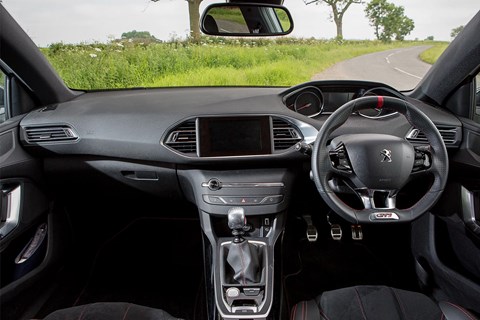
When we drove a pre-production car, Peugeot predicted 80% of buyers would opt for the 250. I predicted they wouldn’t, because the 270 costs just £1600 more at £28,455 (parity with the Golf GTI), and it gets a host of mostly mechanical – and highly desirable/costly – upgrades: a 20bhp bump, a proper limited-slip diff (none of this pretend electric stuff), chunky 380mm grooved front discs with four-piston calipers, 19-inch alloys with Michelin Pilot Super Sport tyres, and alcantara/faux-leather-trimmed bucket seats. Apparently 75-80% are actually going for the 250, but I think that’s madness, so I’ve plumped for the 270, along with a restrained £1415 of options specified by Peugeot: pearlescent white paint, full-length panoramic roof, Peugeot Connect SOS and Assistance.
Whichever spec you choose, both feature the same suspension set-up. The dampers are uprated, the ride height dropped 11mm and spring rates are up 60% at the front and a huge 100% at the rear compared with the 308 GT. You can deduce much from those stats: you’d expect a softer front end to dig into the surface, a firmer rear to dance about, and that’s just what you get. Stringing together a set of mid-paced bends is like dancing through a ski slalom. Lovely.
Both 250 and 270 are the work of Peugeot Sport, a perhaps generic-sounding performance division that exists only in the minds of marketeers, but one that actually has some proper clout. Founded by Jean Todt for Peugeot’s Group B programme in the 1980s, Peugeot Sport more recently helped Seb Loeb smash the Pikes Peak hillclimb record in a 208 as astounded Americans looked on. The spiel is that the same engineers work on the road cars.
I’m taking it gently for now, but it won’t be long until I find out if the magic they’ve wrought translates to British roads.
By Ben Barry

How we specified our Peugeot 308 GTi
- £675 buys the paint: Strong standard spec means options are kept to a minimum, although all were chosen by the Peugeot press office. Pearlescent white paint adds £675 to the tally
- £500 buys the roof: The panoramic roof (£500) lets light flood into the cabin, and can be covered by the electric blind. But the full-length glass can’t be opened, and adds weight up high
- £240 buys the rescue: Peugeot Connect SOS and Assistance (£240) alerts emergency services if you crash… so long as you have phone signal at the bottom of that ravine. You can also press the SOS button to connect to SOS call centre. Or press the Lion button for breakdown assistance
Logbook: Peugeot 308 GTi 270
Engine 1598cc 16v turbo 4-cyl, 268bhp @ 6000rpm, 243lb ft @ 1900rpm
Transmission 6-speed manual, front-wheel drive
Stats 6.0sec 0-62mph, 155mph (limited), 139g/km CO2
Price £28,445
As tested £29,870
Miles this month 717
Total miles 1390
Our mpg 33.6mpg
Official mpg 47.1
Fuel this month £105.76
Extra costs £0
Read more CAR magazine long-term tests